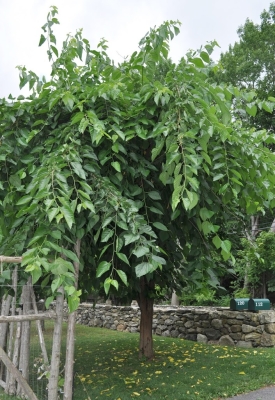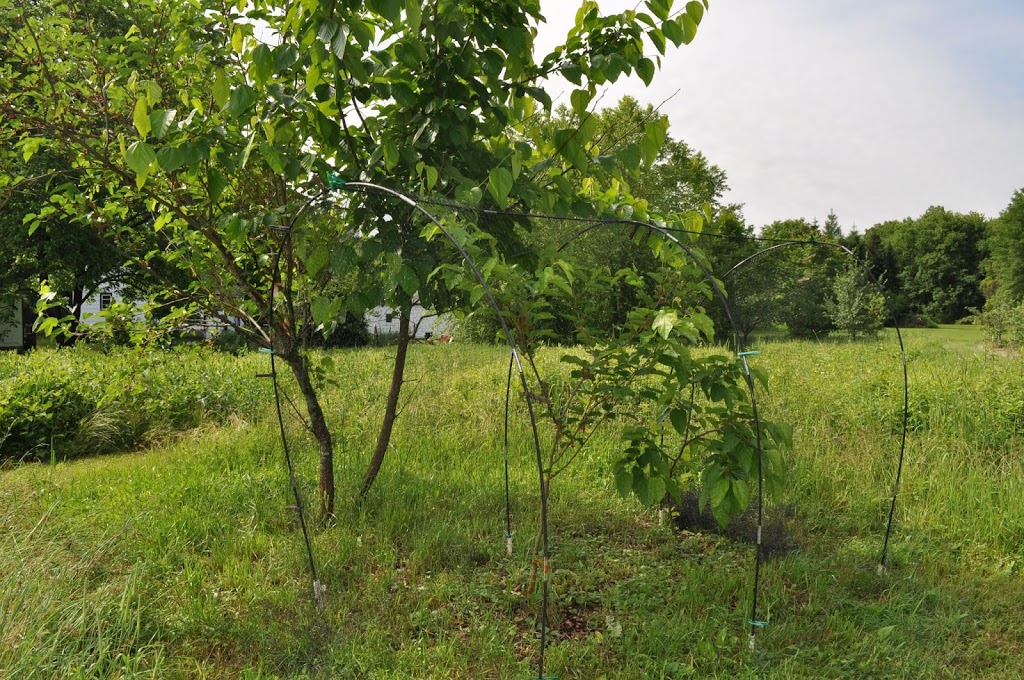I’ve been a fruit nut for a long time, and throughout that time have had a particular attraction to uncommon fruits (about which I wrote a book). Evidence of the latter began with the planting of a mulberry tree in my front yard when I lived in Wisconsin. The plant and fruit seemed intriguing; little did I know, back then, that mulberry trees were growing all over the place. Right now, I could probably bump into a dozen wild trees within a quarter mile of here, or within a quarter mile of my old domicile in Wisconsin. Mulberry is the second most common “weed” tree in New York City.
Commonness is one reason that mulberry doesn’t “get no respect.” Also, fruits from run-of-the-mill trees are too cloying for most tastes. Still, the fruits are abundant, local, organic, and sustainably “grown,”
and some trees have better than run-of-the-mill flavor. The latter are available as named varieties.
Which is why I could be seen today bending flexible poles aver two small trees. Mulberry fruits are a favorite of birds; I needed to protect the fruits. The two trees — the varieties Oscar and Kokusu — allegedly bear delicious fruits. Taste of the fruit from these small trees will confirm whether or not they are worth keeping and growing into larger trees. If worth keeping, the trees, once large, will bear enough for the birds and humans.
My bird protection was easily erected. The ends of the flexible poles, in short sections held together by an inner elastic cord (from www.gardeners.com), like tent poles, went into foot-long pieces of PVC pipe that I pounded into the ground. Clothespins hold bird-netting in place on the poles and metal staples pinned the netting to the ground.
———————————————–
 |
| ‘Illinois Everbearing’ fruit |
Three species of mulberry are commonly eaten: white mulberry, Morus alba; red mulberry, M. rubra; and black mulberry, M. nigra. (Fruit color has nothing to do with species names; many white mulberry trees bear black fruits.) In the eastern part of the U.S., we find our native red mulberry as well as white mulberry, introduced from Asia in the early 19th century, as well as hybrids of the two. Black mulberry thrives best in Mediterranean-type climates.
Right next to my two little trees I have an older mulberry, the variety Illinois Everbearing, a natural hybrid of the white and red mulberry species that does indeed bear over many weeks. My Oscar tree is probably a variety of white mulberry. Kokuso is sometimes listed as its own species, M. latifolia. At any rate, all three varieties are supposed to be hardy and delicious.
 |
| ‘Illinois Everbearing’tree |
I can vouch for Illinois Everbearing because I’ve grown it for a number of years. Although hardy, branches often die back because they don’t realize, towards the end of summer, that it’s time to slow down growth and toughen up for winter. I make it slow down as summer wanes by letting grass and weeds grow high at its feet, sucking up excess moisture and nutrients.
————————————————
The best-tasting of the mulberries, I’d even stick my neck out so far as to say perhaps the best-tasting of all fruits(!), is the black mulberry species. The berries aren’t particularly big but they pack enough flavor that they could be the size of an orange. Their flavor has a nice balance of sweetness and tartness along with some . . . je ne sais quoi. Mulberryness?
Problem is that black mulberry is not hardy here. I’ve grown it in a pot, but a potted plant has only a limited amount of stems on which to hang fruits so yields are very low. I planted one right in the ground in the greenhouse a few years ago, planning to espalier it as directed in my book, The Pruning Book: “To train a
 |
| M. nigra in greenhouse, prior to its demise |
mulberry to a tidy form, develop a main set of limbs, then prune branches growing off these limbs to six leaves in July to make short, fruiting spurs.” Not so! I garnered that pruning information from a British book, and it’s evidently is another gardening Britishism that doesn’t work on this side of the pond, probably due to differences in daylength and/or summer temperatures. My tree has done nothing but grow and grow, with little fruit on the abundant, lanky stems.
This week I ripped the black mulberry out of the greenhouse and planted, in its stead, a fig to accompany the three other in-ground figs there.
A few weeks ago, before the black mulberry awoke from its winter slumber, I cut off a branch and grafted it onto a similarly sized branch of the Illinois
 |
| Morus nigra fruits |
Everbearing tree. Black mulberry isn’t supposed to be cold-hardy outdoors here, but who knows? It’s a very long shot. As I said, I can’t believe everything I read, even if I wrote it. This time I hope that all of us are wrong.







